The Archives
-
Management, Marketing, tourism bc
Tourism BC 2010 Online Olympics activities: #12 – Battlestar Olympia
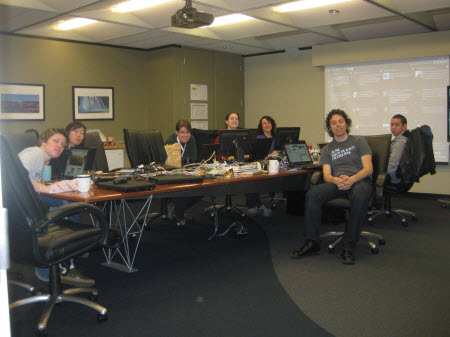
Tourism BC’s online team: Sarah, Jeanine, Holly, Karen, Mikala, William, Jose (on a PPC mission at the time: Dima)The traffic on our websites during the games was significant enough to have a day-to-day look at our tactics and adjust where necesary. What’s media talking about? What are people talking about in social media? Is there a cool story we can leverage through content? Is there something unexpected? Should we send a Field Reporter? Do we make adjustments to our PPC campaigns? Daily huddles and conference calls with our online partners allow us to quickly change plans.

We turned one of our boardrooms into a command centre for the occassion: the Battlestar. Watching the games on a big screen and real time Tweets. Because we’re geeks after all.
This is also my opportunity to thank everybody on the online team, other Tourism BC teams and our partners who were instrumental in making the best use of this Olympic opportunity!
-
Internet, Marketing, tourism bc
Tourism BC 2010 Online Olympics activities: #11 – Social Media
An event like the Olympics makes all media, including social media, light up like a Christmas Tree. Everybody’s talking about it, and that’s exactly what we want. Instead of adding to the noise, our strategy for social media during the games focussed on supporting and encouraging key influencers while leveraging our own network.
Listening

Tourism in BC related social media volume during February
Social media is the largest focus group out there so we treat it as a huge research opportunity. Data has been collected and will be analyzed. We’ve also used our monitoring tools to provide insights to our media, SEM Field Reporters and content teams. This enabled us to quickly respond to unexpected stories.
After the games, we can look at the data to identify what resonated about Vancouver and BC as a destination, potential new markets or product opportunities and key influencers in social media for future engagement.
Assisting and encouraging key influencers
Working with key influencers is a lot like working with travel media professionals (with a twist) especially since many traditional travel media have their own blogs. But there are also pure social media influencers, including local bloggers, athlete tweeters, etc. Jose from our online team has been working closely with our Travel Media team to coordinate efforts.
Building our community

We used the pre-Olympics to experiment with running contests on Twitter. We managed to more than triple our number of followers by giving away some Olympic tickets. We were wondering if people would leave right after, but they didn’t and instead are engaging with Karen, our tweeter extraordinaire, and re-tweeting our messages to their networks.
As an added bonus, our contest winners have been tweeting and blogging about their experiences and traveled around with our Field Reporters.
Engaging our community

Facebook fans and Twitter followers are a diverse group of BC residents, past visitors, tourism industry stakeholders and people who would like to visit. During the games, we tweeted information about the games, general trip ideas based on what was being talked about and re-tweeted messages from others. URLS’s were being tracked and during the games period, drove almost 50,000 visitors to our website.
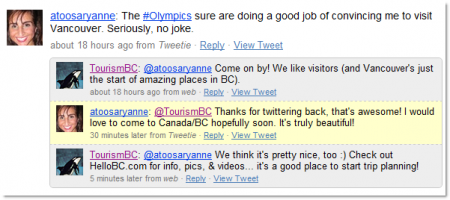
Karen set up searches in Tweetdeck to filter people who expressed an interest in visiting and started the conversation to make the trip a reality leading to wonderful conversations, new followers and hopefully visitors soon.
Lifepoints campaign

Lifepoints is a Facebook application where you get points for your life experiences. Points are based on how people have rated each experience. Compete with your friends for who gets the most out of life and create your own bucketlist by ‘wanting’ things. A natural fit with tourism so we’re running a campaign with Lifepoints to highlight some of the great experiences British Columbia has to offer and promote our contest.
Field Reporters
And of course we wanted to capture the excitement of the games through our Field Reporters. They’ve been all over town, and the rest of the province, to capture the Olympic vibe, the reactions from spectators, athletes and celebrities, against the backdrop of the destination. -
Internet, Marketing, tourism bc
Tourism BC 2010 Online Olympics activities: #8 – grow our consumer database
We want to mitigate the risk that when the games are over, we’ll be out of sight, out of mind. All activities are geared towards making sure the impression we make is a big one and over the last few days I’ve shared our strategies to maximize the destination awareness and get people to start thinking about a possible visit by visiting our consumer websites.
Part of our post-games strategy is to be pro-active when the games are over and we’re putting a lot of energy into growing our consumer database. That way, we don’t have to rely on people remembering BC is great, but we can pro-actively tap them on the shoulder and remind them. Our database marketing program has evolved into sophisticated event based communication, customized to individual consumer profiles. The more consumers we can add to the database, the better guarantee for success.
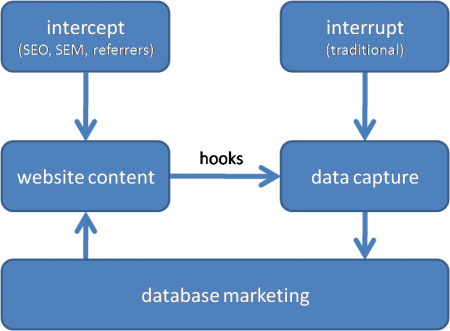
The chart above show our model for our typical approach to driving website visitation and data capture (growing our consumer database).
Intercept
Intercept tactics are targeting consumers who are specifically looking for information we provide. And in previous posts I already described some of the main activities we’re engaged in during the games; SEO/SEM and referral links. These tactics are proven to be very effective at driving highly qualified visitors.
Interrupt
Interrupt tactics are more traditional and includes things like online display advertising. These tactics aren’t necessarily targeting people who are looking for our information but target the people who fit our target audience. They might be looking for something else like medal standings and the purpose of the advertising is to get them interested in our message.
That’s why we use very direct and strong call-to-actions. In the case of the Olympics, a contest to win a trip to BC. We’ve learned that interrupt tactics aren’t the most effective at driving website visitation, but very effective at growing our consumer database (data capture).
Hooks
Intercept tactics drive a lot of qualified visitors to our website. We try to grow our consumer database by leveraging these visitors through hooks. Hooks are tactics on the website with the purpose of growing our consumer database (data capture). We run contests, offer free brochures, maps, eNewletters and more. It’s like fishing in your own pond by adding value to the consumer.
Putting it all together
We use the model above to make investment decisions. For example (note: completely fictional numbers): if it costs $25 to get add a consumer to our database through an interrupt tactic, and we add 1% of our website visitors to our database, a cost per click of $0.25 through a PPC campaign would achieve the same results from a data capture perspective. Plus we’d get 100 qualified people on the website.
Finding the right balance between all objective leads to the right investment strategy.
-
Internet, Marketing, tourism bc
Tourism BC 2010 Olympics online activities: #4 – drive to web strategy
Billions of people watch the games on TV. And the games are the biggest commerical a destination can wish for. Because besides the stories about sports and athletes, the destination plays a lead part.

TV viewing has changed. People watch TV together even if they’re not in the same location using laptops and phones. Research conducted almost 3 years ago during the NBC finals shows that people multitask while watching sports.
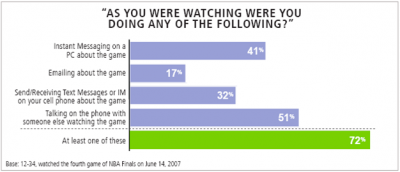
It’s one thing to read research about people texting, IM-ing, tweeting and posting on Facebook. But when I came home one night and I saw my wife Sheri watching Americ’s next top model, while texting her friend and chatting with her sister on Facebook it became real to me.
People also watch TV online. During the Beijing games, 52 million people in the US watched a video stream on NBCOlympics.com. In Europe and China even more people streamed the games online.
The point us that it’s easy for somebody to research something that catches their attention on TV. When somebody is intrigued by the destination story, a laptop or other mobile device is close by. That means a big opportunity for us to follow through on the initial awareness created through the games and encourage consumers to start the trip planning process.

Our strategy to drive people to our consumer websites during the games involves using refering links from high traffic Olympic related websites, Search Engine Otimization and Marketing, advertising and social media. I’ll highlight each one in the next few days.
-
Internet, Marketing, tourism bc, Travel & Tourism, Uncategorized
Tourism BC 2010 Olympics online activities: #1 Strategy
The 2010 Olympic and Paralympic Winter Games are starting today! It’s been a crazy few years and I’ve learned a lot. It’s been a good ride and a good time to share some of our activities and learning. Let’s start at the beginning.
Our marketing objective to leverage is to turn games interest into destination interest and action. Our online strategies are:
- Maximize exposure
- Drive to our consumer websites
- Use the website to put BC on the ‘must visit’ list
- Capture consumer data for future database marketing and increase fans and followers
Over the next two weeks, I’ll share how we’ve executed against these strategies. Stay tuned.
-
Marketing, tourism bc
Great Mountain Giveaway
Have you ever been on a great Ski mountain with 1,000 other people and wondered what it would be like to have the whole mountain to yourself? Well, your dream could come true. We’re giving away a mountain at one of our Ski resorts for a whole day.
And it gets better. You get to bring 19 of your friends.
A mountain in one of our great 13 Ski resorts to yourself with 19 of your friends for a day. For real. Enter our Great Mountain Giveaway.
-
Internet, Marketing, social media, tourism bc, Travel & Tourism
The DMO site as a social platform; moving closer
The future of DMO websites needs real time and social content. Yesterday, our Torch Relay Field Reporter program is a good example of a step towards real time content. And I use social in a broad sense. It means collaboration with people who have a personal or commercial interest in assisting potential travelers to visit a destination.
In our case, our province is a collection of regions, cities and communities; most with their own DMO. Last year our regions took a bold step and decided to use their region on HelloBC as their website. Instead of both spending time and money on development, content, SEO, SEM, etc, we’re now collaborating and HelloBC is better for it.
Most DMO’s are also using Twitter now. Twitter is a great way to connect our website visitors with local experts and give them real time information about regions and communities. So we’re starting to add the local DMO twitter feeds to the relevant pages of HelloBC.
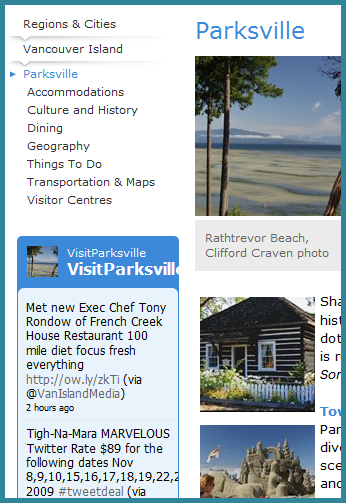
Parksville Twitter feed on HelloBC
Another step towards a more social and real time website.
-
Internet, Marketing, social media, tourism bc, Travel & Tourism
Tourism BC and Field Reporter videos as an example of industry collaboration
Last year, I posted about our online video strategy. It’s been one exciting year. Ten field reporters have created more than 120 videos. With an average time of 3 minutes per video, it’s the equivalent of 4 feature films! Videos are posted on YouTube, our blogs, and they’re incorporated into the appropriate places of the website. In less than a year, our field reporters are approaching 200,000 views.
That alone is enough reason to call these videos a success. But I think the most interesting piece is the way we’re extending our Field Reporter program and leveraging the long tail. Tourism BC can never create videos for every place, event and activity in British Columbia.
Our Field Reporter videos are cost-effective. It’s a one person operation. The host also operates the camera and does the editing. Producing videos is no longer a big budget operation.
That means they’re affordable for smaller destinations and tourism businesses. So we’ve made our Field Reporters available for our industry. We’ve taken care of the process and format of the video. All the industry has to do is pay the Field Reporter and the videos can be used as any other on YouTube and HelloBC, but also on the DMO or operator website.
This concept is working well and a good example of using a collaberative approach to online marketing between a DMO and it’s industry.
The video above was created by Chris on behalf ot Tourism Nanaimo.
This video is created by Ivan on behalf of Canadian Mountain Holidays.
More about our Field Report program soon… -
Internet, Marketing, Travel & Tourism
More about Tourism BC’s Online Video Strategy: Field Reporters
10.26.08 | Permalink | 4 CommentsA few weeks ago I posted about our call for video field reporters. I also promised more details. Here we go.
Our video strategy is multi-faceted based on the opportunities that are currently available. Some are traditional and some are new. But they’ll all work together in a framework.
Let’s first examine the types of tourism related videos out there.
First, there’s the destination video. Emotional music, breathtaking scenery, friendly people, incredible experiences. The intent is to create a strong emotional connection with somebody. The content include all the core brand attributes and the target audience enjoying them. These videos are often used at consumer and/or tradeshows and most destinations have put these videos on their websites and video networks such as YouTube.
Destination Marketing Organization’s TV commercials are often a mini version of the destination video. Sometimes, they include a touch of humour or clever creative, like this video from Utah. But they always include all the core brand tributes again. Watch the Utah commercial and you know what they market and who they market to. Often there’s a call to action to visit a website, a fulfillment piece (guide) or a price point (often through a trade partner).
Then there are the travel host videos, as you will find on travel shows on TV. A host visits a destination and documents some of his or her experience in an informal documentary style. Usually all the “must sees” are covered. Sometimes, if it’s a special interest show, a specific experience is covered.
New on the scene are DMO created documentaries. These highlight a specific iconic experience of a destination. Often, there’s also a host involved and it’s informative and specific to an iconic experience.
And there are the user generated videos of course. Nothing is more credible than real experiences from real people. The amazing video above was the winner of the best user generated video at the eTourism awards last year.Each type of video has a specific purpose. From creating awareness through creating an emotional connection, to real and authentic experiences that makes somebody think “I can be part of this story”. We’re currently in the process of creating a new destination video, TV commercials and documentaries. We’re also encouraging consumers to share their videos with us on our blog section.
But what’s interesting is that we believe there’s room for an additional category, a variation of the travel host, with a user generated content feel. We call these “field reporter” videos. Last year we experimented with this concept.
The video above is one of our ski host video. The intent of the video was to create an authentic video but still hit on the core brand message. The result was positive. Chris did a great job and consumers responded positvice, but our key learning was that we created something that felt a bit off. It didn’t feel authentic, and it wasn’t a slick documentary either.Together for our agency (Cossette Communication Group) we re-defined the video host concept and renamed it to “field reporters”. The idea was to hire 6 people who with good personalities who can handle a video camera. We would send them out into all corners of BC and document their experiences. In order to make it authentic, they have to find somebody and ask for a recommendation. After the recommendation, they need to follow through and document their experience. Nothing planned, nothing staged. They had to be host, camera person and editor. We did add our logo at the beginning of each video to be transparent that we asked these people to create these videos.
And that’s what we’ve done over the last month. We found 7 very talented individuals and send each one to each of our 6 tourism regions, and one on a circle tour on his motorbike. We did give each a list of “iconic” tourism products so they had an idea what was going on in the area. They all made 5-7 videos each. We will use these videos on HelloBC to complement our existing content.
Below is a sample.
Here’s Chris climbing the Squamish Chief.
Ivan visited Bella Coola, and found a first nation person to take him to old Petroglyphs.
Kelli visited the Thompson Okanagan and hiked the Kettle Valley trail.
Mike visited the Kootenay Rockies and was told to visit Fort Steele and the Bull River Guest Ranch near Cranbrook.
Ami was told to take a train ride from Prince Rupert to Prince George through Northern British Columbia.
And Gary rode the Coast Cariboo Circle Tour his motor bike.
We’re also encouraging our staff, communities and industry to create their own videos. It’s easy enough to do. All you need is a video camera and some video editing software.
Some have already taken us up on the challenge. Clint from our Norther BC region create the video above.
And here’s our online team member Mikala’s visit to a farmers marketBy posting these videos on our blog, hopefully we’ll even inspire some BC residents and our travelers to give our their tips and insider information. The intent is to get many video’s capturing the diverse range of tourism experiences throughout the province. We will still use the destination video and professionally produced documentaries to get people excited, and the videos created by field reporters, industry, communities, staff and user will capture the details.
To watch all field reporter videos, keep an eye on Tourism BC’s YouTube channel and our Field Reporter playlist. Our field reporters are still editing some of their videos, so more will be added soon. -
Internet, Marketing, tourism bc
Tourism BC’s blog widget
09.30.08 | Permalink | 2 CommentsBelow you’ll find our Share the Excitement widget. We’re all very excited about here at Tourism BC.
This widget allows anybody to publish our blog entries on their own website. Every time a new entry is added to HelloBC, the content on the widget will also be updated,
We get a lot of questions from communities and operators in BC about consumer blogs. They ask if they should start their own. But without some significant website traffic, it would be very hard for smaller destinations and businesses to create critical mass. By collaborating on generating the right User Generated Content for all of British Columbia, we can all benefit through this widget.
The entries can be filtered by a British Columbia community so you can only show entries from a particular part of BC. Our Share the Excitement mark also contains our connection with the 2010 games.
The widget is available for download on HelloBC. It’s available in 3 sizes and 3 colours. It should be extremely easy for a webmaster to include it in any website.
We’re in the process of developing some new initiatives around HelloBC blogs. Stay tuned for more.


